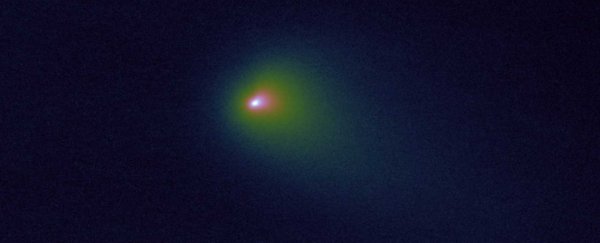Earlier this year, a comet that wandered into the Solar System from a distant star appeared to have met its demise when it started to break apart. But appearances can be deceiving, and a new analysis of 2I/Borisov's fragmentation has found that the main body of the comet will survive its encounter with the Solar System.
It's a win-win situation. The comet did partially break up, which means scientists can analyse the debris from its interior to try to understand its composition; and the icy space rock's epic journey across the galaxy will continue on.
2I/Borisov exploded onto the scene in August of last year, when it was officially spotted for the first time. It was zooming through the Solar System at a trajectory and velocity that indicated an interstellar origin - making it the second known interstellar visitor, and the first known interstellar comet.
It reached perihelion - its closest point to the Sun - on 8 December 2019 and continued on its merry way, its path curving slightly due to the Sun's gravity. But in March of this year, it started acting up.
Polish astronomers noticed an increase in brightness, which they put down to outbursts of dust and ice that were "strongly indicative of an ongoing nucleus fragmentation".
In late March, new observations from the Hubble Space Telescope confirmed it: 2I/Borisov was in at least two pieces, according to a dispatch posted on The Astronomer's Telegram by a teama team led by David Jewitt of the University of California Los Angeles.
Now, Jewitt and his team have analysed those data, and found that a full disintegration is unlikely.
"Our observations reveal that the outburst and splitting of the nucleus are minor events involving a negligible fraction of the total mass," they wrote in a new paper, which is available on the pre-print server arXiv. "2I/Borisov will survive its passage through the planetary region largely unscathed."
It's not uncommon for comets from the outer Solar System to disintegrate after perihelion. It's thought that ices in the comet sublimate, which speeds up the comet's spin. The added torque from this process increases centripetal instability, which causes the comet to break apart.
Given that 2I/Borisov exhibited several characteristics in common with comets from the outer Solar System, its fragmentation was anticipated as a strong possibility.
According to the new paper, however, the March outburst was relatively minor after all. Here's how it went down. From March 4 to 9, the comet brightened considerably - a cometary outburst.
About three weeks after the outburst, on March 30, a secondary chunk of comet was spotted. But by April 3, the second chunk had disappeared; nor was it visible in March 28 observations.
According to the calculations made by Jewitt and his team, the early March outburst was a cloud of about 100 square kilometres (38.6 square miles) across, consisting of particles about 0.1 millimetres in size. This cloud had an estimated mass of about 20 million kilograms (44 million pounds).
That's only a negligible fraction of the nucleus, which the team estimated at 300 billion kilograms (660 billion pounds), based on a radius of 500 metres (546 yards) calculated from high-resolution measurements of the object's surface.
The secondary object that appeared later was around 600 square metres (717 square yards) in size, corresponding to a mass of about 120,000 kilograms (265,000 pounds). The team believes this chunk broke off the main nucleus during the early March outburst, but didn't appear for several weeks.
This allowed the team to calculate how it appeared, and why it disappeared.
"The delayed appearance and rapid demise of the secondary together suggest an origin by spin-up and rotational bursting of one or more large (meter-scale) boulders under the action of outgassing torques," they wrote in their paper.
Astronomers have been keeping a close eye on the comet; so far, no further outbursts have been reported, indicating that the interstellar visitor remains intact, and survived the stresses of perihelion that many comets do not.
"Overall," the researchers wrote, "our observations reveal that the outburst and splitting of the nucleus are minor events involving a negligible fraction of the total mass: 2I/Borisov will survive its passage through the planetary region largely unscathed."
Hip hip, hooray!
The research is available on the pre-print resource arXiv.

